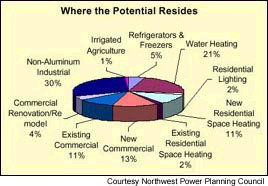forum
library
tutorial
contact

Pacific Northwest Gears Up for Conservation Power Plant
by GreenBiz.comEnvironmental News Network, December 3, 2001
|
the film forum library tutorial contact |

|
Pacific Northwest Gears Up for Conservation Power Plantby GreenBiz.comEnvironmental News Network, December 3, 2001 |
 PORTLAND, Ore.-– An agency of four Northwestern states has proposed a regional conservation "power plant" that would yield at least 300 average megawatts over three years. If approved by member states, the plan could deliver a wide-ranging, economical, efficient, and reliable power supply.
PORTLAND, Ore.-– An agency of four Northwestern states has proposed a regional conservation "power plant" that would yield at least 300 average megawatts over three years. If approved by member states, the plan could deliver a wide-ranging, economical, efficient, and reliable power supply.
According to the Northwest Power Planning Council, which is reviewing feedback on its proposal following a public comment period, this energy-savings target would help maintain conservation efforts and even out energy prices, which for decades have been erratic regionwide.
The council consists of representatives from Idaho, Montana, Oregon and Washington, and is directed by the Northwest Power Act of 1980, which established a program to protect, mitigate and enhance fish and wildlife of the Columbia River Basin that have been affected by hydropower.
The Council also supports the recent energy policy adopted by many Western governors, which favors conservation. According to a new Council issue paper, "An Efficiency Power Plant in Three Years: An Interim Goal for the Northwest" rather than accelerating and decelerating conservation acquisition in response to the swings in market prices, sustaining a level of investment that is justifiable in light of expected average prices can prove valuable "during periods of upward volatility."
Council staff said they believe about 100 aMW in annual regional energy savings can be achieved at levelized costs below 4 cents per kilowatt-hour, and generally below 3 cents/KWh. Total estimated cost of this resource is about $250 million per year -- at least half of which is pledged to various conservation initiatives.
That compares to the Council's current levelized cost estimate of about 3.6 cents/KWh for a natural gas-fired combined-cycle combustion turbine. Council power planning director Dick said that accomplishing the conservation goal would be the province of utilities, public-purposes administrators and large consumers.
"We're not trying to make this into a 'heat police' kind of exercise," Watson said. "This is really trying to use the Council's bully pulpit to encourage people to do it."
Watson said Council staff seek to even out the ups and downs that have characterized Northwest energy conservation over the past two decades.
"Get off the roller coaster -- that's the operative phrase," said Watson.
Conservation Power Plant The issue paper lauded the region's "admirable record of conservation development," peaking at nearly 140 aMW in 1993.
"The rate of acquisition, however, fell off dramatically in the latter years of the decade," owing to such factors as uncertainties over electric industry restructuring and expectations of low wholesale power prices.
From 1997 through 2000 regional utility conservation totaled less than 200 aMW -- about half of what the Council considered cost-effective. Then came the energy crisis, which saw many utilities focusing on conservation measures that could be implemented quickly.
The Council notes that record numbers of compact fluorescents have been sold over the past year with incentives from regional utilities, but that the challenge requires more aggressive solutions. Moderating wholesale prices and potentially excess capacity could squelch new power generation development until demand once again exceeds supply. Or many planned new power plants may not get built, and reliability could suffer in low water years.
"Either scenario suggests that we ought to re-think our approach to conservation," the Council said.
In assessing prospects for sustainable conservation funding, the Council issue paper finds the signs are mixed. Positives include public-purposes funding in Oregon and Montana, aggressive demand-side efforts by some publicly owned and investor-owned utilities, Bonneville Power Administration's conservation/renewables wholesale rate discount, and utility rate increases that are likely to expand customer interest in energy efficiency.
Conservation Numbers The Council will develop a new power and conservation plan, probably by 2003, according to Watson. This proposed 100 aMW annual energy-saving goal is intended as an interim goal.
"Here are some numbers we feel fairly confident of, and let's go do it instead of dropping the conservation acquisition back down," he said. According to Watson, some 60 percent of potential savings lies in the commercial and industrial sectors.
"This implies that the conservation investment should contribute directly to making the economy of the Northwest more efficient and more risk resistant," he said.
Council staff estimates the total annual cost of this conservation power plant at $250 million. At least half that amount is already earmarked for Bonneville's C/RD, the Northwest Energy Efficiency Alliance and the Energy Trust of Oregon.
And that doesn't include IOU spending outside Oregon, large public-power utility conservation and customer funding for energy-saving measures.
The notion of a conservation power plant would communicate energy savings as a resource tangibly equivalent to a generating facility, while expressing the region's intentions for energy diversity, according to the council. Council staff would allocate the conservation goal among utilities, public-purposes administrators and major retail consumers with direct access to power markets.
Related Sites:
Northwest Power Planning Council
Con.Web
learn more on topics covered in the film
see the video
read the script
learn the songs
discussion forum
